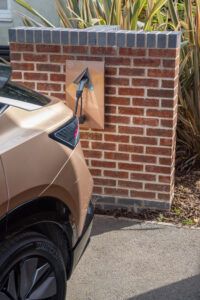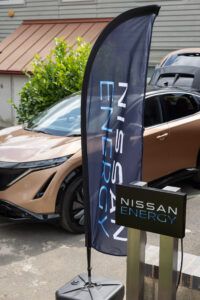Car-to-grid growth, battery improvements and a clean transition from ICE to EV, Nissan engineers around the globe have rather a lot on their collective plates. John Challen finds out what they’re as much as
With an ever-growing variety of EVs – from legacy producers in addition to startup organizations – persevering with to flood the automotive market, drivers aren’t in need of choices. And the applied sciences and improvements carry on coming. Some may say that the extent of maturity the trade has seen may imply it’s time to take the foot off the gasoline (or somewhat the electrical energy), however R&D groups know in any other case.
For Nissan, the present massive targets that require an enormous quantity of funding, engineering and enthusiasm are vehicle-to-grid (V2G) capabilities and bringing strong state batteries to market. The Japanese producer not too long ago revealed extra plans in these areas and suffice to say, it’s totally dedicated to seeing them by.
Within the case of V2G, Nissan confirmed that onboard bi-directional charging would function on chosen EVs from 2026. The information got here as a lift for the OEM’s marketing strategy – The Arc – which acknowledged the requirement to ship ‘differentiated innovation that allows the EV transition, whereas unlocking new income streams’. The V2G mission additionally sits on the coronary heart of Ambition 2030, Nissan’s long-term imaginative and prescient of a world that’s cleaner, safer and extra inclusive.
“In all places on this planet, the vitality market is evident the place we can provide extra to our clients. It’s very promising for them as a result of, if we play it effectively, we’ll cease talking about zero emission and it is going to be damaging emission,” says Hugues Desmarchelier, vice chairman of worldwide electrification ecosystem and programme director for EV vehicles at Nissan. “If issues go to plan, each automotive that we promote will probably have the ability to assist the grid and the vitality market through the use of renewable vitality extra of the time. That’s not simply if you’re driving an EV, it’s additionally if you’ve parked the car, as a result of you’ll be able to assist the grid by giving energy again.”
On this win-win scenario, Desmarchelier believes that this strategy will cancel out the carbon footprint generated by automotive manufacturing. “When you can cut back the CO2 footprint if you construct the automotive, then we will have what I want for my children – a world the place, if you purchase an EV, you aren’t solely carbon impartial – probably – you may as well have a constructive influence on the CO2 everywhere in the world.
“We began vehicle-to-home initiatives a very long time in the past and we have now 18,000 clients concerned with it in Japan. However at present you want subsidies as a way to make it work, as a result of it’s an costly course of,” he admits, explaining that greater than 40 pilot initiatives since 2012 have satisfied Nissan that V2G is the precise means ahead. “Right now, we’re in the beginning of this journey – and that’s why we don’t wish to wait. Although the regulation just isn’t at all times prepared, with our companions we try to pressure our means into this world to make a distinction from at present. However actually, we’re making ready for the long run.”
 Mannequin efficiency
Mannequin efficiency
Nissan EVs which can be outfitted with V2G bi-directional charging expertise will contribute in direction of serving to the electrical energy grid, particularly at peak instances. Beginning with the UK however trying to rollout the expertise everywhere in the world, Nissan has already achieved G99 Grid code certification with an AC-based resolution for a V2G utility. Awarding of the benchmark follows a year-long mission on the College of Nottingham, the place research confirmed the potential for V2G, for drivers and in addition the broader trade – and the world.
David Moss, SVP of analysis and growth for the AMIEO area at Nissan believes V2G can also be wanted make EVs extra inexpensive and worthwhile. “Our goal is to carry the price of our automobiles down by 35%,” he explains. “Alongside the price discount, we’re additionally trying to enhance effectivity and in addition the driving expertise.” Nissan’s strategy is focused on widespread powertrain parts wherever potential, which has led to its ‘X-in-1’ powertrain setup. Meaning in both a 3-in-1 (EVs) or 5-in-1 (ePower) configuration, the inverter, reducer and motor will likely be commonized and modularized. For ePower, an increaser and electrical generator will likely be added into the combo however designed and developed to maximise effectivity. The end result will likely be powertrains which can be as much as 25% smaller than the present variations.
Plant development
Bolstering Nissan’s providing within the EV trade is a large funding in battery expertise and manufacturing, in addition to ongoing R&D into various kinds of chemistries that could possibly be appropriate for future automobiles.
For instance, a Gigaplant that’s at present below development in Sunderland, UK is a joint growth between Nissan and battery producer Envision AESC, and covers an space the equal of 23 soccer pitches. That appears big however, as Moss factors out, it’s solely actually able to supporting one of many EVs that being produced on the Japanese producer’s manufacturing unit close by. What’s necessary, nonetheless, is the product being constructed there. “We’re utilizing a brand new chemistry as a result of we’re dedicated to shifting the product on – each from a value viewpoint, but additionally an vitality density standpoint,” he explains. “We’re specializing in nickel manganese cobalt (NMC) and all-solid-state batteries (ASSB). In Japan there may be some work occurring round lithium iron phosphate (LFP) cells, however they don’t seem to be as vitality dense, and they’re heavy too. Clearly one of many greatest challenges with EVs is, effectivity, as a result of effectivity is king.
“Aero could be very a lot dictated by the styling, so we at all times have to make the automotive mild,” he provides. “So, wanting on the parts – and the way we enhance the effectivity of them – is the massive driver. For us, it’s all about figuring out how we will get extra out of the battery and onto the driving vary – as a result of our clients measure issues on how far they’ll go. That and charging speeds.”
Early outcomes gathered by Nissan engineers present loads of promise for ASSB. “For the prototype components that we’ve been testing, we do see a soar within the efficiency [over existing technologies]. Some individuals might need different applied sciences up their sleeves however, to this point, we see an enormous job, and we’re dedicated to engaged on it,” says Nissan’s Shunsuke Shigemoto, VP e-powertrain and superior analysis.
“The important thing factor is ensuring there’s no liquid in it,” furthers Moss. There’s strong state after which there’s all-solid-state – and we’re involved with all strong state. Liquids are temperature-dependent and wish to change state. When the electrolytes boil, they create gasses, they usually wish to react with every part that’s round them. By way of driving and charging, you get to the purpose the place the battery administration kicks in to manage the temperature of the battery. With strong state, you’ve obtained much less of a difficulty, so that you simply preserve charging.
“We’ve executed a great deal of simulations the place we at all times have a look at an 800km drive and, if you journey these distances, we have now to consider how lengthy you will drive earlier than it’s essential to cease on the companies or for lunch,” provides Moss.
Infrastructure is fascinating, says Moss and one other space that Nissan has investigated. “We do loads of surveys throughout Europe and, now we have a tendency to seek out that, for any chargers entering into now, voltage isn’t an issue. We do see a difficulty with the present and the way that present is split between a number of automobiles being charged. We’ve checked out what the accessible charging energy is and how much voltage to placed on board to your charger. Getting that stability proper is an enormous problem as a result of clearly the completely different voltages on the onboard modifications the ability electronics rather a lot.”
 Stable as a clock
Stable as a clock
Wanting forward in time, Nissan has dedicated to introducing its first solid-state batteries in an utility by 2028. A date for worth and efficiency parity with present applied sciences, nonetheless, is rather less clear. “A variety of it’s right down to investments and payback and, if you put it into one other automotive, it’s by no means the identical simply swapping a Duracell for an Ever Prepared,” causes Moss. “The batteries behave so otherwise. So, if we alter the cooling and all the opposite algorithms round it, we have now to contemplate how lengthy the automotive has been available in the market and if the payback has been made on the unique battery funding.
“One other subject is across the measurement and packaging implications,” he provides. “What does that do with the packaging within the car? Do you wish to put the battery someplace else, as a result of technically it could possibly be half the scale. In the intervening time, should you have a look at something battery pack that’s 80kW and above, the entire house between the entrance and rear wheels is taken up by cells. With solid-state expertise, you possibly can make it thinner, nevertheless it additionally provides us extra choices past that.”
Moss talks in regards to the adoption of skateboards and admits that there are packaging constraints for rear passengers the place they’ve restricted clearance for his or her toes. With that in thoughts, he’s relishing the chance to do one thing completely different with a future solid-state-battery based mostly platform. But it surely comes with numerous questions. “How does the mass change? Does that imply that the crash construction is now over engineered? Will we optimize it and get the load down and the effectivity up? There are such a lot of various factors to play with,” he says.
Total, although, Moss believes that what Nissan – and the broader trade is doing – is making a distinction. “What clients suppose is their barrier to switching to EV – and what’s now thought of an appropriate vary – is altering on a regular basis,” he causes. “Individuals are realizing that there are extra charging stations, they usually can see charging charges going up. So, the suitable driving vary determine is not going to be the identical determine in a couple of years’ time. Then the query is, how usually do you drive 800km? For most individuals, a few hundred miles might be sufficient. But when individuals actually wish to pay for the additional battery capability, at the very least they’ll have that choice.”
Hy and dry?
In relation to hydrogen, Moss acknowledges that Nissan “did numerous work on hydrogen a couple of years in the past”, however issues are a bit quieter on that entrance now. “At that stage, we obtained to the purpose the place what we had been seeing a crossover within the various kinds of automobiles and a choice needed to be made about which might be the higher expertise,” he says. “You possibly can’t afford to put money into every part and, as strong state turned extra promising – and the nagging doubt remained about the place to get the hydrogen from – we centered our efforts elsewhere. So, hydrogen just isn’t one thing that we’re actively selling in the mean time.
That stated, Shunsuke Shigemoto wasn’t ruling it out utterly simply but. “We at all times taking a look at every part and different potential alternatives, for instance the manufacturing course of could possibly be supported by inexperienced vitality, however the quantity of vitality truly essential to create hydrogen from water molecule is sort of vital.”


